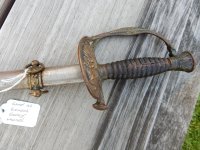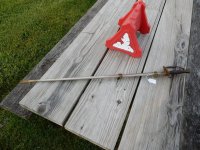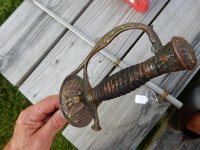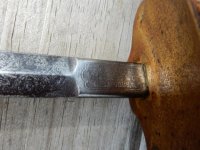Going thru my stuff I took a look at this Civil War Sword by Ames. I have seen the exact same sword on display at Gettysburg a few years ago with General Meade's uniform. I have it tagged as an 1851 US Field and Calvary Sword. Am I correct?
-
Forum Update: We've upgraded the software to improve security, performance, and the overall experience.
👉 Read why we made the change | Support the Forum
You are using an out of date browser. It may not display this or other websites correctly.
You should upgrade or use an alternative browser.
You should upgrade or use an alternative browser.
Civil War Sword verification
- Thread starter moosedog
- Start date
Register to hide this ad
It is not a cavalry sword. The blade is straight.
444 Magnum
Member
- Joined
- Jan 6, 2011
- Messages
- 1,189
- Reaction score
- 7,181
Definitely not a field sword. The embellishments and straight blade lend more to a presentation sword or a ceremonial sword.
Can you make out the inscription?
Some swords in this style were presented post-war to officers from their men at reunions, etc.
There are websites that have very knowledgeable people in these areas.
Can you make out the inscription?
Some swords in this style were presented post-war to officers from their men at reunions, etc.
There are websites that have very knowledgeable people in these areas.
That's a US Model 1860 Staff and Field Officers Sword.
The same basic pattern was was used after the war by the GAR.
Photo of GAR sword swiped off web...

The same basic pattern was was used after the war by the GAR.
Photo of GAR sword swiped off web...

Last edited:
Cavalry carried curved sabers That is ceremonial senior officers sword.
Apropos of the curved cavalry swords from the Civil War era, I have read that they were intended more for bludgeoning an enemy — e.g, breaking his collar bone, rendering him senseless with a head blow — rather than, say, cutting off or into body parts.It is not a cavalry sword. The blade is straight.
Would be interesting to learn of 19th Century cavalry saber training.
Thank you. Correction duly noted.
444 Magnum
Member
- Joined
- Jan 6, 2011
- Messages
- 1,189
- Reaction score
- 7,181
I am by no means an expert. That's why I suggested you find a forum that specializes in these type weapons.
The knuckle guard and embellishments are different than those on the US Model 60 posted. Even the grip dimensions look different.
I would research it.
The knuckle guard and embellishments are different than those on the US Model 60 posted. Even the grip dimensions look different.
I would research it.
swagmeister
Member
- Joined
- Apr 24, 2010
- Messages
- 1,086
- Reaction score
- 1,366
CivilWarTalk.com
VaTom
Member
Apropos of the curved cavalry swords from the Civil War era, I have read that they were intended more for bludgeoning an enemy — e.g, breaking his collar bone, rendering him senseless with a head blow — rather than, say, cutting off or into body parts.
Would be interesting to learn of 19th Century cavalry saber training.
Prior to WWI George Patton was in the Calvary. He redesigned the Calvary saber and the new design was accepted by the Army. Still the same design today.
Model 1913 Cavalry Saber - Wikipedia
Last edited:
Prior to WWI George Patton was in the Calvary. He redesigned the Calvary saber and the new design was accepted by the Army. Still the same design today.
Model 1913 Cavalry Saber - Wikipedia
Cavalry, not Calvary.
- Joined
- Apr 21, 2021
- Messages
- 4,541
- Reaction score
- 7,726
Patton was also one of very few that wore the “sword qualification” badge.
smoothshooter
Member
More people have been screwed over buying what they thought were authentic Civil War swords than you can count.
Just like WW II German military medals.
Just like WW II German military medals.
DWalt
Member
The edges of cavalry sabers were purposely left unsharpened for that reason. The appearance of revolvers during and after the Civil War made sabers unnecessary for cavalry use other than ceremonial.Apropos of the curved cavalry swords from the Civil War era, I have read that they were intended more for bludgeoning an enemy — e.g, breaking his collar bone, rendering him senseless with a head blow — rather than, say, cutting off or into body.
Last edited:
smoothshooter
Member
Cavalry carried curved sabers That is ceremonial senior officers sword.[/QUOTo
Curved blades were slashing.
Straight ones were for impaling.
I got CW musicians swords and NCO swords that I got dirt cheap from a gun dealer that had no interest in edged weapons and display them on a rack on the wall. I made sure they were clean and then I coat them with Renaissance wax occasionally to protect them. Oil on them has the disadvantage of absorbing dirt and dust to itself.
Aggie1906
US Veteran
My understanding of Civil War Cavalry swords, some generations removed from my relatives experience, is slashing is good and piercing is bad. Sword knot or no, you likely will leave your sword behind that way. Something like throwing your knife, and finding you have no knife.
My feeling during Basic bayonet practice, was "Not while I have bullets!"
Quartermaster issue reports showed the Michigan Cavalry boys started with Burnsides and Sharps, followed by Spencer rifles, then carbines. Lots of 1860s in .44. Some .36 Navys too.
I have a Roby period Light that I was lucky enough to find for sale. Some of the guys got the old, heavy wrist breakers too. From a book I was guided to called "Arming Michigan's Regiments". Not that anybody ever fudged any quartermaster reports. Ha!
My feeling during Basic bayonet practice, was "Not while I have bullets!"
Quartermaster issue reports showed the Michigan Cavalry boys started with Burnsides and Sharps, followed by Spencer rifles, then carbines. Lots of 1860s in .44. Some .36 Navys too.
I have a Roby period Light that I was lucky enough to find for sale. Some of the guys got the old, heavy wrist breakers too. From a book I was guided to called "Arming Michigan's Regiments". Not that anybody ever fudged any quartermaster reports. Ha!





